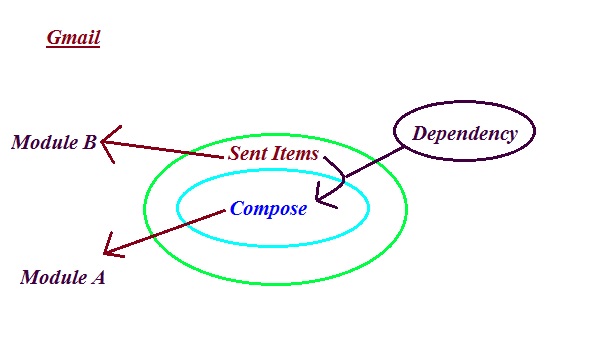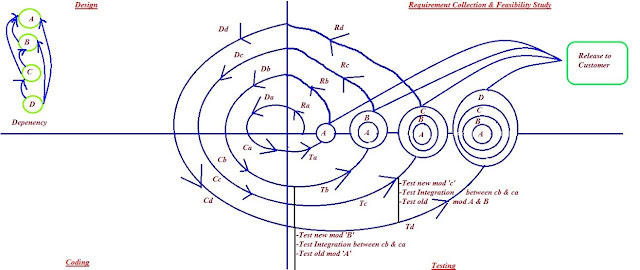Spiral Model
Description
It is a step by step procedure or standard procedure to develop a new software.
To overcome the drawbacks of waterfall model we go for spiral model. Spiral model is mainly used when there is dependency between the modules.
It is also called as iterative and incremental model.
Dependency Eg
Spiral Model Architecture Diagram
Explanation
MOD 'A'
- Customer will give requirement for module 'A' in business language.
- Business Analyst will do requirement collection for module 'A' and in the same stage Feasibility Study will be done.
- Architect will do design for module 'A' (i.e. High Level Design and Low Level Design).
- Developers will write the code for module 'A' and give the software to test engineer and Test Engineer will test the module 'A'. While testing if Test Engineer find any defect communicate to Developer and Developer will fix the defect and give the new software to Test Engineer.
- Test Engineer will uninstall old software install new software test the defect first and continue testing for module 'A'.
- Once module 'A' is tested and quality of the software is good then software will be released (Installed) to the customer.
MOD 'B'
- Customer will give requirement for module 'B' and he will tell there is a dependency between 'B' and 'A'.
- Business Analyst will do requirement collection for module 'B' and in same phase Feasibility Study will be done.
- Architect will do the design for module 'B' (i.e. High Level Design and Low Level Design).
- Developer will write the code for module 'B' and give software to Test Engineer.
- Test Engineer will first test new module 'B' .
- Test Engineer will then check integration between module 'B' and 'A'.
- Test old module 'A'.
- Once all the testing is completed software quality is good then release both 'A' and 'B' module to the customer.
MOD 'C'
- Customer will give requirement for module 'C' and he will tell there is a dependency between 'CA' and 'CB'.
- Business Analyst will do requirement collection for module 'C' and in same phase Feasibility Study will be done.
- Architect will do the design for module 'C' (i.e. High Level Design and Low Level Design).
- Developer will write the code for module 'C' and give software to Test Engineer.
- Test Engineer will first test the new module 'C'.
- Test Engineer will then check integration between module 'CA' and 'CB'.
- Then he will test the old module 'B' and 'A'.
- Once all the testing is completed software quality is good then release all three module 'A', 'B' and 'C' to the customer.
MOD 'D'
- Customer will give requirement for module 'D' and he will tell there is a dependency between 'DC', 'DB' and 'DA'.
- Business Analyst will do requirement collection for module 'C' and in same phase Feasibility Study will be done.
- Architect will do the design for module 'D' (i.e. High Level Design and Low Level Design).
- Developer will write the code for module 'D' and give software to Test Engineer.
- Test Engineer will first test the new module 'D'.
- Test Engineer will then check integration between module 'DC', 'DB' and 'DA'.
- Then he will test the old module 'C' , 'B', and 'A'.
- Once all the testing is completed software quality is good then release all the module 'A', 'B', 'C' and 'D'.
Why the model is called incremental model ?
In every cycle we keep on adding new module so the model is called incremental model.
Why the model is called iterative model ?
Ans: In every cycle same process is repeated so the model is called iterative model.



ConversionConversion EmoticonEmoticon